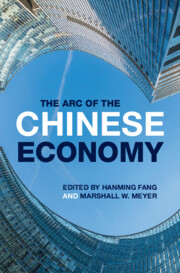Refine search
Actions for selected content:
689 results
4 - Digital Platforms: A New Natural Monopoly?
- from Part I - The Competitors in the Digital Network Industry
-
- Book:
- Regulating Competition in the Digital Network Industry
- Published online:
- 20 November 2025
- Print publication:
- 04 December 2025, pp 85-112
-
- Chapter
- Export citation
3 - The Ownership Structure of Zimbabwe’s Diamond Sector
-
- Book:
- Zimbabwe's Diamond Trade
- Published online:
- 06 November 2025
- Print publication:
- 04 December 2025, pp 52-73
-
- Chapter
- Export citation
4 - Mode of Exchange in Zimbabwe’s Diamond Sector
-
- Book:
- Zimbabwe's Diamond Trade
- Published online:
- 06 November 2025
- Print publication:
- 04 December 2025, pp 74-93
-
- Chapter
- Export citation
Feedlot Imprimatur: Public-Private Cooperation in the Advent of Government Beef Grading
-
- Journal:
- Enterprise & Society , First View
- Published online by Cambridge University Press:
- 02 December 2025, pp. 1-24
-
- Article
- Export citation
La liberalización y desregulación del sector bancario español entre 1971-1990 y efectos sobre el poder de mercado
-
- Journal:
- Revista de Historia Economica - Journal of Iberian and Latin American Economic History , First View
- Published online by Cambridge University Press:
- 01 December 2025, pp. 1-34
-
- Article
-
- You have access
- Open access
- HTML
- Export citation
1 - Nature and Sources of Labour Law
- from Part I - Introduction
-
- Book:
- Labour Law
- Published online:
- 02 October 2025
- Print publication:
- 20 November 2025, pp 3-45
-
- Chapter
- Export citation
Criminal Law and Criminological Aspects of Combatting Fraud
-
- Journal:
- International Annals of Criminology , First View
- Published online by Cambridge University Press:
- 13 November 2025, pp. 1-20
-
- Article
- Export citation
8 - Just Don’t Get Caught!
- from Introduction to Part I
-
-
- Book:
- Human Rights in the Digital Domain
- Published online:
- 24 October 2025
- Print publication:
- 13 November 2025, pp 138-150
-
- Chapter
-
- You have access
- Open access
- HTML
- Export citation

The Arc of the Chinese Economy
-
- Published online:
- 30 October 2025
- Print publication:
- 13 November 2025
4 - Regulatory Design, Trust, and Voluntary Compliance
-
- Book:
- Can the Public be Trusted?
- Published online:
- 11 October 2025
- Print publication:
- 30 October 2025, pp 92-120
-
- Chapter
-
- You have access
- Open access
- HTML
- Export citation
The competence–control trade-off in military AI innovation: Autonomous weapons systems and shifting modes of state control over private experts
-
- Journal:
- European Journal of International Security , First View
- Published online by Cambridge University Press:
- 29 October 2025, pp. 1-21
-
- Article
-
- You have access
- Open access
- HTML
- Export citation

Human Rights in the Digital Domain
- Core Questions
-
- Published online:
- 24 October 2025
- Print publication:
- 13 November 2025
-
- Book
-
- You have access
- Open access
- Export citation
13 - Inframarginalism and Economism
-
-
- Book:
- Toward an Inframarginal Revolution
- Published online:
- 26 September 2025
- Print publication:
- 16 October 2025, pp 468-491
-
- Chapter
- Export citation

Can the Public be Trusted?
- On the Promise and Perils of Voluntary Compliance
-
- Published online:
- 11 October 2025
- Print publication:
- 30 October 2025
-
- Book
-
- You have access
- Open access
- Export citation
11 - Drawing from AMR Experience for Better Prevention, Preparedness, and Response to Complex Health Threats under a One Health Approach
- from Part II - One Health and Contemporary Legal Structures
-
-
- Book:
- The Cambridge Handbook of One Health and the Law
- Published online:
- 25 September 2025
- Print publication:
- 09 October 2025, pp 157-180
-
- Chapter
- Export citation
6 - Regulatory Intervention
-
- Book:
- Regulating a Thousand Cuts
- Published online:
- 27 September 2025
- Print publication:
- 09 October 2025, pp 130-176
-
- Chapter
-
- You have access
- Open access
- HTML
- Export citation
11 - Design for Regulating a Thousand Cuts
-
- Book:
- Regulating a Thousand Cuts
- Published online:
- 27 September 2025
- Print publication:
- 09 October 2025, pp 310-330
-
- Chapter
-
- You have access
- Open access
- HTML
- Export citation
Chapter 30 - Emotion and Affective Disorders
- from Section VII - Individual Differences
-
-
- Book:
- The Cambridge Handbook of Human Affective Neuroscience
- Published online:
- 16 September 2025
- Print publication:
- 02 October 2025, pp 604-617
-
- Chapter
- Export citation
Chapter 26 - Neural Evidence for Cultural Variation in Emotion
- from Section VI - Social Emotions
-
-
- Book:
- The Cambridge Handbook of Human Affective Neuroscience
- Published online:
- 16 September 2025
- Print publication:
- 02 October 2025, pp 523-543
-
- Chapter
- Export citation
Chapter 18 - Episodic Emotional Memory
- from Section IV - Emotional Learning and Memory
-
-
- Book:
- The Cambridge Handbook of Human Affective Neuroscience
- Published online:
- 16 September 2025
- Print publication:
- 02 October 2025, pp 363-382
-
- Chapter
- Export citation
